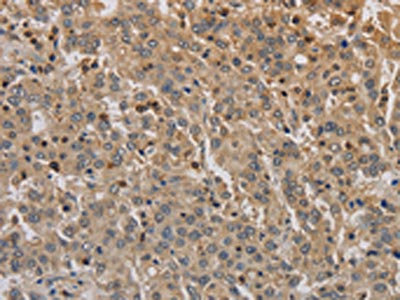
The image on the left is immunohistochemistry of paraffin-embedded Human liver cancer tissue using CSB-PA934409(ADO Antibody) at dilution 1/30, on the right is treated with synthetic peptide. (Original magnification: x200)
ADO Antibody

CSB-PA934409
ApplicationsWestern Blot, ELISA, ImmunoHistoChemistry
Product group Antibodies
ReactivityHuman
TargetADO
Overview
- SupplierCusabio
- Product NameADO Antibody
- Delivery Days Customer20
- ApplicationsWestern Blot, ELISA, ImmunoHistoChemistry
- CertificationResearch Use Only
- ClonalityPolyclonal
- ConjugateUnconjugated
- Gene ID84890
- Target nameADO
- Target description2-aminoethanethiol dioxygenase
- Target synonyms2-aminoethanethiol (cysteamine) dioxygenase; 2-aminoethanethiol dioxygenase; C10orf22; cysteamine (2-aminoethanethiol) dioxygenase (ADO); cysteamine dioxygenase
- HostRabbit
- IsotypeIgG
- Protein IDQ96SZ5
- Protein Name2-aminoethanethiol dioxygenase
- Scientific DescriptionHuman thiol dioxygenases include cysteine dioxygenase (CDO, MIM 603943) and cysteamine (2-aminoethanethiol) dioxygenase (ADO, EC 1.13.11.19). CDO adds 2 oxygen atoms to free cysteine, whereas ADO adds 2 oxygen atoms to free cysteamine to form hypotaurine. Mouse Ado has strong and specific dioxygenase activity in vitro towards cysteamine but not cysteine. Recombinant Ado was shown to bind iron. Overexpression of Ado in HepG2/C3A cells increased the production of hypotaurine from cysteamine. Similar results were found with human ADO. When endogenous expression of ADO was reduced by RNA-mediated interference, hypotaurine production decreased. The demonstration of high levels of ADO in brain challenges the previous assumption that most of the taurine in the brain is a consequence of CDO activity.
- ReactivityHuman
- Storage Instruction-20°C or -80°C
- UNSPSC12352203

